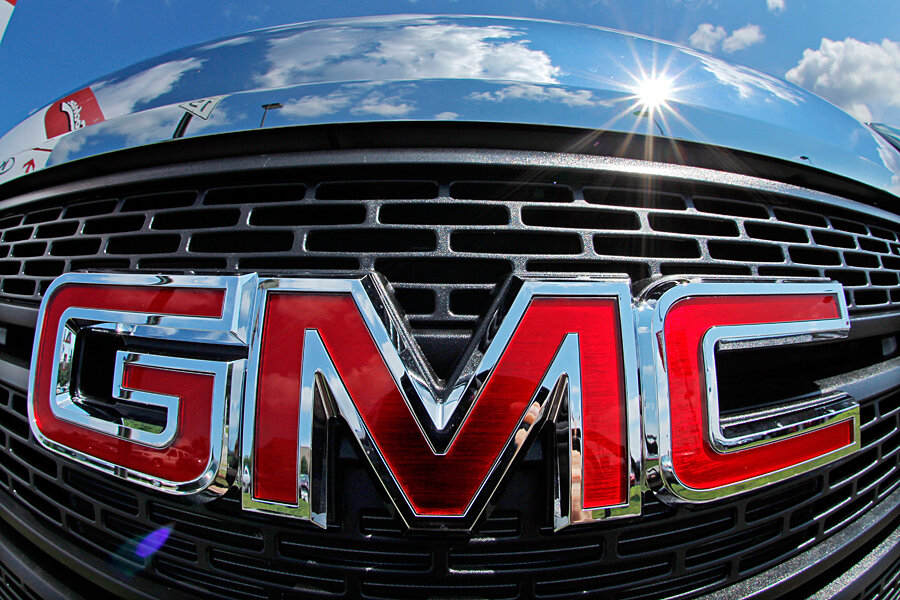Treasury to sell last GM shares from auto bailout. How'd taxpayers fare?
Loading...
The Treasury Department is finally getting out of the automotive business, five years after interceding to rescue the US industry from apparent annihilation at the onset of the Great Recession. On Thursday, it announced it sold 70.2 million shares of General Motors (GM) stock and intends to sell its remaining 31.1 million shares by Dec. 31.
Once the final sale is complete, however, US taxpayers will have lost nearly $10 billion of the $49.5 billion the federal government used to prevent the auto giant from collapsing in 2008, Treasury officials say. The loss offsets a greater calamity that would have occurred – the disappearance of 1 million jobs – if the federal government had not intervened, says Treasury Deputy Assistant Secretary Tim Bowler.
“Had we not acted to support the automotive industry, the cost to the country would have been substantial – in terms of lost jobs, lost tax revenue, reduced economic production, and other consequences. Our actions have enabled the industry to rebound,” Mr. Bowler said in a statement Thursday.
In 2008, when GM warned Congress that the company would collapse unless it secured federal aid, the Bush administration stepped in to provide $13.4 billion. An additional $35 billion came during Obama administration. In return, the government received controlling interest of the company, helping to steer it through bankruptcy proceedings in July 2009.
To date, the US government has recouped about $38 billion by selling 811 million of its 912 million shares. The late-year sale will bring that figure to $39.6 billion.
Another of Detroit's Big Three automakers, Chrysler, also received federal dollars and bankruptcy protection. Today, the company is owned by Italian automaker Fiat, which is credited with helping it rebound by instituting a diversified vehicle lineup and better marketing. Chrysler's third-quarter earnings this year were $464 million, a 22 percent increase from the $381 million it earned in the third quarter of 2012.
The goal of the federal bailout was ultimately to bolster the economy, not benefit a single car company, says Gerald Meyers, a professor at the University of Michigan Ross School of Business in Ann Arbor and the former chairman of American Motors.
“It wasn’t just GM [that was threatened], it was the whole supply chain underneath it, and the dealer organizations, and the customers’ retention to a US producer. If you track that all the way down, [the $10 billion loss] was cheap,” Professor Meyers says. “There was not a better alternative, and it certainly was worth it.”
GM remains the largest US automaker. The company says its recovery can be illustrated by profits: 14 consecutive profitable quarters since the bailout, and earnings of $8 billion in 2012. The company also spent $9 billion to expand or create 34 US manufacturing facilities in Michigan, Kansas, and Texas, creating about 25,000 jobs. GM’s October sales jumped 16 percent compared with the same month last year. Year-to-date sales in October are up 12 percent.
However, maintaining market dominance remains a trouble spot for GM. Its US market share is about 18 percent, but competitors Ford and Chrysler are nipping at its heels. In the first nine months of 2013, GM sales increased 7.6 percent compared with a 12 percent boost in Ford sales and 8.7 percent for Chrysler.
During its recovery, GM halved the number of brands, from eight to four, and limited its vehicle production. The company also aggressively expanded models within those brands to create diversity. While large trucks and SUVs still dominate in GM sales, the company is working to be competitive in categories such as small and midsize vehicles.
“They had to make up a lot of ground coming out of the bankruptcy to cover a lot of the basics,” says Michelle Krebs, a senior analyst for Edmunds.com in Detroit. “They now have a lot of breadth and depth to their product line. Now the next step is to be more consistent across the board with quality.”








